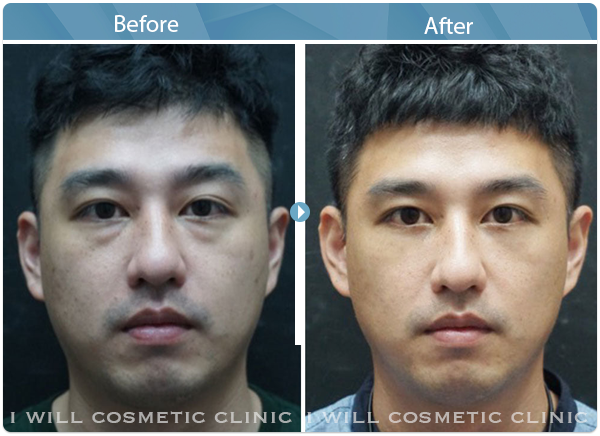Eyebag Surgery
What is Eye Bag surgery?
It also called blepharoplasty of the lower eyelid, is a cosmetic procedure that helps correct lose skin, excess fat, and wrinkles of the lower eye area.
As you age, your skin naturally loses elasticity and fat padding. This can make the lower eyelid appear puffy, wrinkled, and baggy. Lower eyelid surgery can make the undereye smoother, creating a more youthful look.
Eye Bag surgery works by removing excess skin and fat and sewing the skin under the eye back together, giving the undereye area a tighter appearance.
There are delicate structures around the undereye, including eye muscles and the eyeball itself. The surgery requires a delicate, precise approach to smooth the undereye area and make it appear less puffy.
Several surgical approaches exist for lower eyelid surgery. The approach usually depends on your goals for your under eye area and your anatomy.
While the incision sites may vary, a doctor will make cuts into the lower eyelid. Your doctor will then remove excess skin and fat and suture or sew the skin back together to create a smoother, lifted appearance.
Your doctor may also recommend fat grafting or injecting fat to hollow areas under the eyes to give them a fuller appearance.
Relocate clumping fats under eye to the hollow areas (removing unnecessary fat)
In lower eyelid bags surgery, fat in the lower eyelids can be removed or repositioned through a scar-less incision hidden on the inner surface of the eyelid (transconjunctival blepharoplasty), thereby creating a more smooth, natural, rested appearance to the eyes.
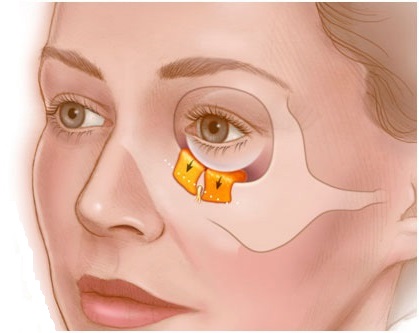
The medial and middle fat transfer to the hollow tear trough area.
Uses a special technique to reposition or redistribute the fat under the eyes to concurrently fill in the hollow area below it, called transconjunctival lower blepharoplasty with fat repositioning. This special cosmetic eyelid procedure achieves two things at the same time: 1. removes under eye fat pads;2. fills in the hollow tear trough area (dark circles).
※This procedure avoids the hollow sunken eye appearance if fat is merely removed.

STEP 1:design the rearranging areas under the eyelids based on a patient's eyelids condition prior to surgery.
STEP 2:conjunctival incision inside of eyelids
STEP 3:relocate clumping fats under eye to the hollow areas (removing unnecessary fat)
STEP 4:suture in the inner eye conjunctiva
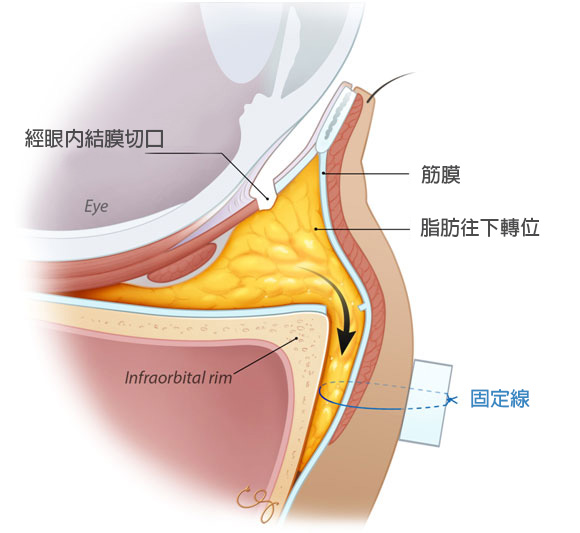
The hidden transconjunctival (inside lower eyelid) incision has additional advantages:
⑴ the scar is hidden;
⑵ the incision is stitch-less with much quicker healing;
⑶ avoids potential damage to the orbicularis oculi muscle (responsible for closing the eye and blinking) which can cause the lower eyelids to get pulled down (eyelid retraction) with inability to close the eyes (lagophthalmos) and dry eyes.
This is especially important with patients with prominent eyes (negative vector) who are at increased risk if proper technique is not used. With proper technique, lower blepharoplasty can safely be done on any patient, including those with prominent bulging eyes or negative vector eye/orbit morphology.
Improving the wrinkles and sagging skin due to aging, fat relocation.
Incision in the lower part of eyelashes,
Pull the sagging skin and muscles, resect the skin if necessary,
Eliminate and relocate bulging fat under eyes at the same time.
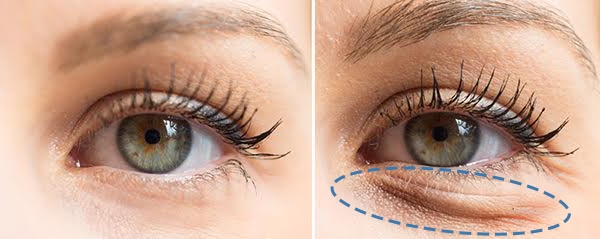
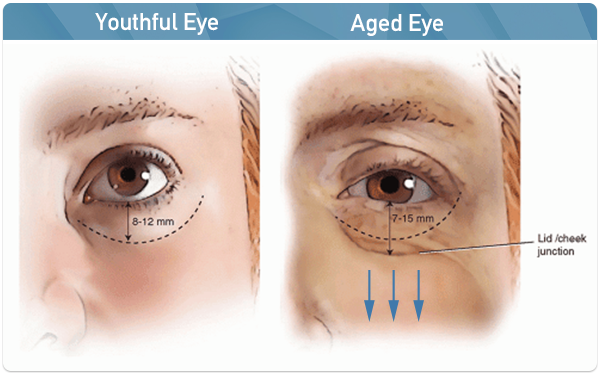
With age, the interface between the lower eyelids and cheeks (Lid Cheek Junction) will gradually decrease, instead of appearing to be lifted and tightened. Therefore, even after the fat and skin are processed, the lower eye area still presents false eye bags with triangles hanging down.
Most hospitals solve this problem by removing and cutting, so the initial impression looks rather fierce.
But we maintain and raise your youthful look through the process of lifting and filling, making you look 10 years younger.

STEP 1:accurately identify the current eye condition with the specialist
STEP 2:incision under eyelashes, remove and relocation of fat under eyes(liad skin resection if necessary), muscle reinforcement.
STEP 3:suture the fat tissue firmly.
STEP 4:improving fat protrusion and sagging under-eye skin without apparent scar.
We conduct the transconjunctival fat removal and transconjunctival lower
blepharoplasty with fat repositioning according to each individuals' wrinkles and skin
condition.
The suborbicularis oculi fat (SOOF) is a very important tissue to maintain the apple cheeks of the mid-face. When aging, this tissue will shrink and droop, resulting in a thin and old appearance.
In order to recreate the roundness of the apple cheeks and enhance the interface between the eyelids and the cheeks, we will "lift the suborbicular oculi muscle fat (SOOF)" together with the "orbital fat displacement and fascia fixation" to compare the upper and lower fats Large and wide cross shift and lifting to increase the volume of the apple cheeks.
This is like reusing the "golden fat" that we regard as waste, using cross-overlap methods to remove eye bags, smooth tear grooves, and rebuild apple cheeks.
The "apple cheek/tear ditch mark/bag under eye" area has always been the place where plastic surgery is more difficult. Reconstructing apple cheek with fat golden cross can also be solved at the same time, which can be said to be a three-shot effect.
Severe tear grooves under the eyes and apple cheek wasting, making people look old and lacking energy, fat golden cross reconstruction after apple cheek reconstruction. Not only the bags under the eyes have been eliminated, but the cheeks are also tightened and lifted, and even the nasolabial lines have been improved, and they look 10 years younger!


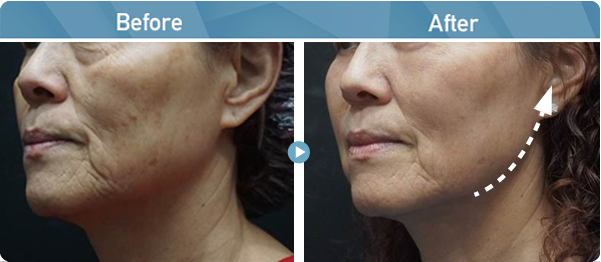
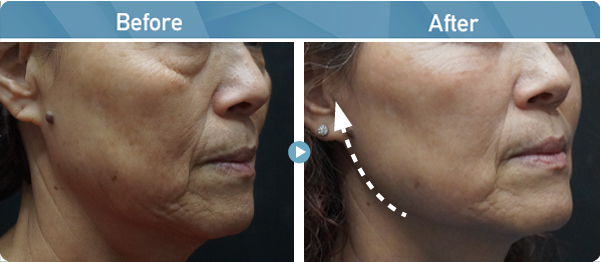
When many people have eye bags, they are afraid of eye bag surgery when they hear of ectropion. In fact, we will assess the degree of eyelid relaxation before surgery.
If the eyelids are relatively loose, then it is recommended to do lower eyelid enhancement, that is, lateral canthopexy, this method does not damage the original lateral canthopexy joints, only strengthen the surrounding tissue.
For patients with severe lower eyelid sagging, or under-eye bag re-repair surgery, the original lateral canthal ligament must be cut off at the attachment of the bone, and the suture must be tightened to prevent or treat eyelid ectropion. This kind of surgery is called lateral canthoplasty/ lateral tarsal strip.
In addition to the condition of the eyelids, the concave and convex eyeballs and the corresponding eye sockets will also be considered for surgery.
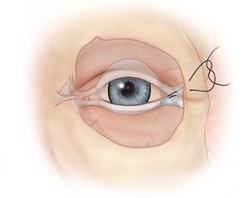
The orbicularis oculi muscle is the muscle surrounding the eyes and is responsible for closing the eyes. With age, muscle sagging and loosening can also form muscle-shaped eye bags.
Because of modern aesthetics, it’s more natural to like a bit of lying silkworms. When opening the eye bags, we will retain the uppermost orbicularis oculi muscle, so as not to damage the natural lying silkworms.
However, for people who are more slack, we will hang them by muscles. Pull the muscles up and fix them on the outer periosteum of the eye, and tighten the muscles to prevent the eyelids from turning out, and secondly, to lift the drooping fat together to make the lower eyelids and cheeks look firmer and younger.
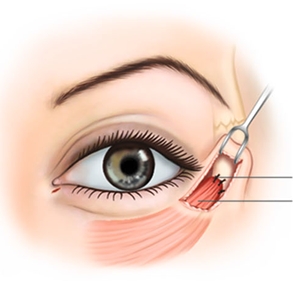
When performing eye bag surgery, we can also perform the depression under the eyes and the filling of the depression of the apple cheeks at the same time.
When the congenital mid-face support is not enough, it is easy to form youthful eye bags. Usually, dark circles appear when they are young. As the age grows, the eye bags become more obvious.
Or due to aging, apple cheek fat atrophy, the middle face sagging and sagging, the fat can also be appropriately displaced during eye plastic surgery, and at the same time, it can fill the middle face with autologous fat to create a rounded apple cheeks.
People with congenital maxillary hypoplasia, these people will have eye bags soon when they are young because they have underdeveloped bones.


With age, the fat itself will be lost and sagging.
